Статьи журнала - International Journal of Image, Graphics and Signal Processing
Все статьи: 1056

An Efficient Brain Tumor Detection Algorithm Using Watershed & Thresholding Based Segmentation
Статья научная
During past few years, brain tumor segmentation in magnetic resonance imaging (MRI) has become an emergent research area in the field of medical imaging system. Brain tumor detection helps in finding the exact size and location of tumor. An efficient algorithm is proposed in this paper for tumor detection based on segmentation and morphological operators. Firstly quality of scanned image is enhanced and then morphological operators are applied to detect the tumor in the scanned image.
Бесплатно
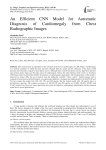
An Efficient CNN Model for Automatic Diagnosis of Cardiomegaly from Chest Radiographic Images
Статья научная
This work presents an algorithm for the automatic detection of cardiomegaly on CXR images. Cardiomegaly is a medical condition in which the heart becomes enlarged than the actual and the efficiency of the heart would decrease and sometimes congestive heart failure occurs. Although there could be numerous reasons, high blood pressure and coronary artery disease are the main causes of cardiomegaly. Hence, the main intention of this work is to develop a CNN based model to efficiently identify the presence of cardiomegaly abnormality. The learning phase of the model is achieved by using CXRs that are extracted from the publically available “chest x-ray14” medical dataset and to compute the proposed model performance, an experimental platform is designed and implemented in the MATLAB tool. We have trained the model with 100, 120, 150, and 200 epochs. But the trained model with 120 epochs shows a revolutionary outcome. The acquired accuracies of 100,120,150 and 200 epochs are 84.69%, 98.00%, 89.09% and 87.64% respectively. However, many approaches have been developed for cardiomegaly identification but the proposed model shows record performance.
Бесплатно
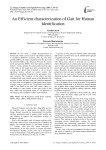
An Efficient Characterization of Gait for Human Identification
Статья научная
In this work, a simple characterization of human gait, which can be used for surveillance purpose, is presented. Different measures, like leg rise from ground (LRFG), the angles created between the legs with the centroid (ABLC), the distances between the control points and centroid (DBCC) have been taken as different features. In this method, the corner points from the edge of the object in the image have been considered. Out of several corner points thus extracted, a set of eleven significant points, termed as control points, that effectively and rightly characterize the gait pattern, have been selected. The boundary of the object has been considered and using control points on the boundary the centroid of those has been found out. Statistical approach has been used for recognition of individuals based on the n feature vectors, each of size 23(collected from LRFG, ABLCs, and DBCCs) for each video frame, where n is the number of video frames in each gait cycles. It has been found that recognition result of our approach is encouraging with compared to other recent methods.
Бесплатно
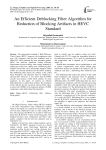
An Efficient Deblocking Filter Algorithm for Reduction of Blocking Artifacts in HEVC Standard
Статья научная
The international standard of High Efficiency Video Coding (HEVC) improves the compression ratio over %50 compared with previous standards such as H264/AVC which maintain the same perceptual quality. HEVC has achieved significant coding efficiency improvement beyond existing video coding standard by employing several new coding tools. Deblocking filter, Adaptive Loop Filter (ALF) and Sample Adaptive Offset (SAO) are currently introduced for the HEVC standard. The deblocking filter detects the artifacts at the coded block boundaries and attenuates them by employing a selected filter. However, it was shown that the HEVC encoder may produce visible block artifacts on some sequences. In this paper, we propose an efficient deblocking filter to reduce block artifacts. The simulation results indicate that the maximum increase Peak signal-to-noise ratio (PSNR) of the proposed method is 0.09db, comparing to other deblocking filter algorithm.
Бесплатно
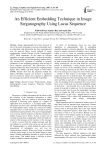
An Efficient Embedding Technique in Image Steganography Using Lucas Sequence
Статья научная
Image steganography have been observed as one of the useful techniques to prevent unintended users to understand what information has been communicated over the network. Many crucial methods of image steganography include Discrete Cosine Transformation (DCT) based approaches. In this paper an efficient algorithm in image steganography is proposed extending DCT based approaches and incorporating number theory. The existing DCT algorithm is modified to increase randomness in the embedding technique with the help of Lucas sequence specifically. The effectiveness of the proposed method has been evaluated by computing Mean Square Error (MSE) and Peak Signal to Noise Ratio (PSNR). Results show that the proposed method has higher embedding capacity and increases a significant level of security by using Lucas sequence in addition to the advantages provided by existing DCT algorithm.
Бесплатно
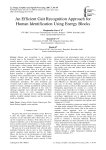
An Efficient Gait Recognition Approach for Human Identification Using Energy Blocks
Статья научная
Human gait recognition is an emerging research topic in the biometrics research field. It has recently gained a wider interest from machine vision research community because of its rich amount of merits. In this paper, a robust energy blocks based approach is proposed. For each silhouette sequence, gait energy image (GEI) is generated. Then it is split into three blocks, namely lower legs, upper-half and head. Further, Radon transform is applied to three energy blocks separately. Then, standard deviation is used to capture the variation in radial axis angle. Finally, support vector machine classifier (SVM) is effectively used for the classification procedures. The more prominent gait covariates such as multi views, backpack, carrying, least number of frames, clothing and different walking speed conditions are effectively addressed in this work by choosing sequential, even, odd and multiple’s of three numbering frames for each sequence. Extensive experiments are conducted on four considerably large, publicly available standard datasets and the promising results are obtained.
Бесплатно
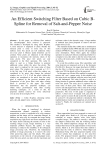
An Efficient Switching Filter Based on Cubic B-Spline for Removal of Salt-and-Pepper Noise
Статья научная
In this paper, an efficient filter method for salt-and-pepper noise removal is proposed. This method is developed by using cubic B-spline. A noise detector is employed to check whether the selected pixel is noisy or noise free. In this method, noise free pixels are left unaltered. Since not every pixel is filtered, undue distortion can be avoided. Noise pixels are subjected to the filtering operation to reconstruct the intensity values of the noisy pixels. The noise free pixels are only considered in the filter operation. The cubic B-spline is used as a fitting function to generate additional values within the noise free pixels. The noisy pixel is replaced by the mean value of these pixel values. The window size is selected as 3 X 3 in the first step. If all pixels within the window are considered to be noise, then change the selected window size to 5 X 5. If all the pixels within this window are considered to be noise, then the noisy pixel is replaced by the previous resultant pixel. Comparison of the given filter with other existing filters is provided in this paper. The results demonstrate that the proposed technique can obtain better performances than other existing denoising techniques. As a result of this, the proposed method removes the noise effectively even at noise level as high as 97%.
Бесплатно

An Efficient System for Medical Image Retrieval using Generalized Gamma Distribution
Статья научная
Efficient diagnosis plays a crucial role for treatment. In many cases of criticalness, radiologists, doctors prefer to the usage of internet technologies in order to search for similar cases. Accordingly in this paper an effective mechanism of Content Based Image Retrieval (CBIR) is presented, which helps the radiologists/doctors in retrieving similar images from the medical dataset. The paper is presented by considering brain medical images from a medical dataset. Feature vectors are to be extracted efficiently so as to retrieve the images of interest. In this paper a two-way approach is adopted to retrieve the images of relevance from the dataset. In the first step the Probability Density Functions (PDF) are extracted and in the second step the relevant images are extracted using correlation coefficient. The accuracy of the model is tested on a database consisting of 1000 MR images related to brain. The effectiveness of the model is tested using Precision, Recall, Error rate and Retrieval efficiency. The performance of the proposed model is compared to Gaussian Mixture Model (GMM) using quality metrics such as Maximum distance, Mean Squared Error, Signal to Noise Ratio and Jaccard quotient.
Бесплатно
Статья научная
Video steganography is used to conserve the confidential information in various security applications. To give advance protection to the secrete message, pixels locations are optimized using nature inspired algorithm. The input video is separated into a sequence of still image frames then key frames are extracted. The proposed Required Pixel Density (RPD) value calculation and feature extraction are carried out on the extracted frames to perform the frame classification. The frame classification is done using proposed Fractional Water-Earth Worm optimization algorithm based Deep Convolutional Neural Network (FrWEWO-Deep CNN) in order to classify the frames as high, low and medium quality. Thus pixel location prediction is carried out using trained Deep CNN then secret image is hide within high quality frame with Wavelet Transform (WT) and Inverse WT (IWT). Peak Signal to Noise Ratio (PSNR) and Correlation Coefficient (CC) are performance evaluation parameters. For efficient video steganography better imperceptibility and robustness are required. Imperceptibility is a scale of PSNR value showing similarity between original and stego video frames. The robustness of video steganography is measured by CC between embedded and extracted secret images. The proposed algorithm gives enhanced performance is compared with previous state of art such as WEWO-Deep RNN. The PSNR value is progressed from 41.8492 to 46.5728 dB and CC value improved from 0.9660 to 0.9847.
Бесплатно
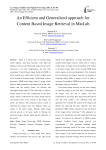
An Efficient and Generalized approach for Content Based Image Retrieval in MatLab
Статья научная
There is a serious flaw in existing image search engines, since they basically work under the influence of keywords. Retrieving images based on the keywords is not only inappropriate, but also time consuming. Content Based Image Retrieval (CBIR) is still a research area, which aims to retrieve images based on the content of the query image. In this paper we have proposed a CBIR based image retrieval system, which analyses innate properties of an image such as, the color, texture and the entropy factor, for efficient and meaningful image retrieval. The initial step is to retrieve images based on the color combination of the query image, which is followed by the texture based retrieval and finally, based on the entropy of the images, the results are filtered. The proposed system results in retrieving the images from the database which are similar to the query image. Entropy based image retrieval proved to be quite useful in filtering the irrelevant images thereby improving the efficiency of the system.
Бесплатно
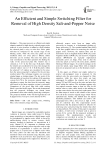
An Efficient and Simple Switching Filter for Removal of High Density Salt-and-Pepper Noise
Статья научная
This paper presents an efficient and simple adaptive method for high density salt-and-pepper noise removal. A noise detector is utilized to check whether the selected pixel is noisy or noise free. Noise pixels will then be subjected to the second stage of the filtering action, while the noise free pixels are left unaltered. Since not every pixel is filtered, undue distortion can be avoided. The noise free pixels are only considered in the filter operation for finding the value of the processed pixel. The window size is selected as 3 X 3 in the first step. If all pixels within the window are considered to be noise, then change the selected window size to 5 X 5. If all the pixels within the selected 5 x 5 window are considered to be noise, then the processing pixel is replaced by the previous resultant pixel. This technique requires one nonnoise original image as training image. The key point of the filter operation is based on the solution of the equations system X=A-1B in the nonnoise original image. An algorithm to extract the data from the nonnoisy image and form it in the linear equation system is presented. Comparison of the given filter with other existing filters is provided in this paper. The results demonstrate that the proposed technique can obtain better performances than other existing denoising techniques. The proposed method works well for high-density salt & pepper noise even up to a noise density of 97%.
Бесплатно
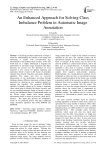
An Enhanced Approach for Solving Class Imbalance Problem in Automatic Image Annotation
Статья научная
Classifying an object captured in an image is useful for understanding the contents of the image and annotating it exactly with corresponding tags automatically is the problem faced recently. As the real world data set is highly imbalanced it degrades the performance of automatic image annotation and object detection. To prevail over this drawback we have proposed a new system for pattern matching and annotation which is based on the fusion of principles obtained from Fractal Transform and gentle AdaBoost algorithm. This paper, also tries to overcome deterioration in the performance occurring through imbalance dataset, different orientation, scaling in image annotation by choosing an over sampling method for learning the classifier. The proposed IFSMOTE classifier is initially trained up by setting a threshold value which helps to identify the objects correctly and an over-sampling technique based on fractal is used to classify the imbalanced dataset. Experimental results on the Flicker image dataset have shown superior performance results in terms of precision, recall and F-measure. This paper also presents the comparative results of our proposed system with other traditional image annotation algorithm like SVM, SMOTE and FSMOTE.
Бесплатно
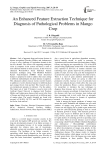
An Enhanced Feature Extraction Technique for Diagnosis of Pathological Problems in Mango Crop
Статья научная
Lack of apparent shape and texture features in disease recognition (Powdery Mildew and Anthracnose) of crop is a key challenge of Agriculture domain in the last few decades. The various soft computing techniques exists in computer vision system still there is need of most efficient methods to meet accuracy. In this work An enhanced Wavelet-PCA based Statistical Feature Extraction technique along with Modified Rotation Kernel Transformation (MRKT) based directional features is proposed in order to address the issues arising in different methodologies for plant disease recognition. This enhanced scheme extracts twenty wavelet features in addition to twelve direction features for different plant parts mango flower, fruit and leaf. This research work is an extended part presents in reference 1 by the authors. The feature set of total 32 features is used to train with Artificial Neural Network to diagnose both Powdery Mildew and Anthracnose disease which occur in the form of Fungus and black spots respectively on different parts of mango plant. The results obtained are found with accuracy of 98.50%, 98.75%, and 98.70% respectively for flower, fruit and leaf .
Бесплатно
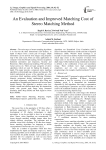
An Evaluation and Improved Matching Cost of Stereo Matching Method
Статья научная
The main target of stereo matching algorithms is to find out the three dimensional (3D) distance, or depth of objects from a stereo pair of images. Depth information can be derived from images using disparity map of the same scene. There are many applications of computer vision like People tracking, Gesture recognition, Industrial automation and inspection, Security and Biometrics, Three-dimensional modeling, Web and Cloud, Aerial surveys etc. There are large categories of stereo algorithms which are used for finding the disparity or depth. This paper presents a proposed stereo matching algorithm to obtain depth map, enhance and measure. The hybrid mathematical process of the algorithm are color conversion, block matching, guided filtering, Minimum disparity assignment design, mathematical perimeter, zero depth assignment, combination of hole filling and permutation of morphological operator and last non linear spatial filtering. Our algorithm is produce noise less, reliable, smooth and efficient depth map. We obtained the results with ground truth image using Structural Similarity Index Map (SSIM) and Peak Signal to Noise Ratio (PSNR).
Бесплатно

Статья научная
Scream is recognized as constant and ear-splitting non-linguistic verbal communication that has no phonological structure. This research is based on the study to assess the effect of regional accent on distress screams of women of a very specific age group. The primary goal of this research is to identify the components of non-speech sound so that the region of origin of the speaker can be determined. Furthermore, this research can aid in the development of security techniques based on emotions to prevent and report criminal activities where victims used to yell for help. For the time being, we have limited the study to women because women are the primary victims of all types of criminal’s activities. The Non-Speech corpus has been used to explore different parameters of scream samples collected from three different regions by using high-reliability audio recordings. The detailed investigation is based on the vocal characteristics of female speakers. Further, the investigations have been verified with bi-variate, partial correlation and one-way ANOVA to find out the impact of region-based accent non-speech distress signal. Results from the correlation techniques indicate that out of four attributes only jitter varies with respect to the specific region. Whereas ANOVA depicts that there is no significant regional impact on distress non-speech signals.
Бесплатно

An Image Hiding Scheme Using 3D Sawtooth Map and Discrete Wavelet Transform
Статья научная
An image encryption scheme based on the 3D sawtooth map is proposed in this paper. The 3D sawtooth map is utilized to generate chaotic orbits to permute the pixel positions and to generate pseudo-random gray value sequences to change the pixel gray values. The image encryption scheme is then applied to encrypt the secret image which will be imbedded in one host image. The encrypted secret image and the host image are transformed by the wavelet transform and then are merged in the frequency domain. Experimental results show that the stego-image looks visually identical to the original host one and the secret image can be effectively extracted upon image processing attacks, which demonstrates strong robustness against a variety of attacks.
Бесплатно
An Image Steganography Algorithm with Five Pixel Pair Differencing and Gray Code Conversion
Статья научная
Steganography involves hiding information in another media. PVD based steganography techniques uses the difference between the pixel values of a pair directly to hide the information. The proposed steganography system modifies the difference value before being used for hiding the information. This makes extraction of hidden data harder in case the steganography system fails. The algorithm divides the cover image in the block of 2 x 3 pixels and calculates average (N) of the bits that can be hidden in five pairs of that block. Thus if the difference value allows M-bits to be hidden in the pair, then only N-bits are hidden in that pair when M >N otherwise M (if M≤N) bits are hidden in that pair. Second level of security is added by converting the secret information into gray code before embedding it in the cover image. The algorithm provides good hiding capacity and improved quality of stego image with two levels of security for the secret information.
Бесплатно

An Improved Convexity Based Segmentation Algorithm for Heavily Camouflaged Images
Статья научная
The paper proposes an advanced convexity based segmentation algorithm for heavily camouflaged images. The convexity of the intensity function is used to detect camouflaged objects from complex environments. We take advantage of operator for the detection of 3D concave or convex graylevels to exhibit the effectiveness of camouflage breaking based on convexity. The biological motivation behind operator and its high robustness make it suitable for camouflage breaking. The traditional convexity based algorithm identifies the desired targets but in addition also identifies sub-targets due to their three dimensional behavior. The problem is overcome by combining the conventional algorithm with thresholding. The proposed method is able to eliminate the sub-targets leaving behind only the target of interest in the input image. The proposed method is compared with the conventional operator. It is also compared with some conventional edge based operator for performance evaluation.
Бесплатно

An Improved DCT based Image Watermarking Robust Against JPEG Compression and Other Attacks
Статья научная
Rapid growth of internet service attains better security of multimedia contents now a days. Heading this problem a DCT-based color image watermarking framework is proposed in this article. Many earlier works have suggested embedding watermark information in the low frequencies of the image to enhance the robustness against JPEG compression because low frequencies hold the most significant information of the image and not affected significantly by the quantization method of JPEG algorithm. Replacement of low-frequency components with watermark directly may incur undesirable degradation to the image quality. To preserve the visual quality of watermarked images, we are proposing a watermarking framework that adjusts the DCT low-frequency coefficients by scaled averaging. The security issue is well-taken care with double secret keys. Experimental result set demonstrates that the embedded watermark can be extracted efficiently from the JPEG-compressed images even after very high compression, re-watermarking, other image processing attacks. The extraction algorithm is blind i.e., neither host image nor the watermark is needed at the time of extraction.
Бесплатно
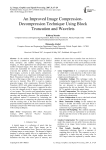
An Improved Image Compression-Decompression Technique Using Block Truncation and Wavelets
Статья научная
In the modern world, digital images play a vital role in a number of applications such as medical field, aerospace and satellite imaging, underwater imaging, etc. These applications use and produce a large number of digital images. Also, these images need to be stored and transmitted for various purposes. Thus, to overcome this problem of storage while transmitting these images, a process is used, namely, compression. The paper focuses on a compression technique known as Block Truncation Coding (BTC) as it helps in reducing the size of the image so that it takes less space in memory and easy to transmit. Thus, BTC is used to compress grayscale images. After compression, Discrete Wavelet Transform (DWT) with spline interpolation is applied to reconstruct the images. The process is suggested in order to view the changed pixels of images after compression of two images. The wavelets and interpolations provide enhanced compressed images that follow the steps for its encoding and decoding processes. The performance of the proposed method is measured by calculating the PSNR values and on comparing the proposed technique with the existing ones, it has been discovered that the proposed method outperforms the most common existing techniques and provides 49% better results in comparison with existing techniques.
Бесплатно

